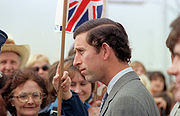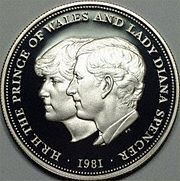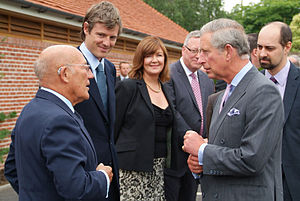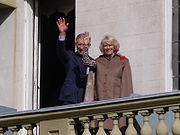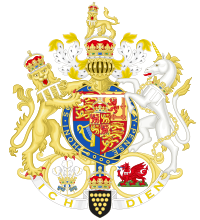
Charles, Prince of Wales
Background to the schools Wikipedia
SOS Children volunteers helped choose articles and made other curriculum material All children available for child sponsorship from SOS Children are looked after in a family home by the charity. Read more...
| The Prince Charles | |
|---|---|
| Prince of Wales; Duke of Rothesay (more) | |
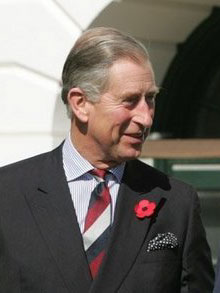 |
|
| The Prince of Wales during a visit to the White House in 2005 | |
| Spouse | Lady Diana Spencer (m. 1981, div. 1996) Camilla Parker Bowles (m. 2005) |
| Issue | |
| Prince William of Wales Prince Henry of Wales |
|
| Full name | |
| Charles Philip Arthur George | |
| House | House of Windsor |
| Father | Prince Philip, Duke of Edinburgh |
| Mother | Elizabeth II |
| Religion | Christian (Church of England & Church of Scotland) |
The Prince Charles, Prince of Wales, KG KT GCB OM AK QSO CD SOM GCL PC AdC(P) FRS (Charles Philip Arthur George; born 14 November 1948) is the heir apparent and eldest son of Queen Elizabeth II. Since 1958, his major title has been HRH The Prince of Wales. In Scotland he is known as The Duke of Rothesay.
Charles was educated at Cheam and Gordonstoun Schools, which his father, Prince Philip, Duke of Edinburgh, had attended as a child. After earning a bachelor of arts degree from Trinity College, Cambridge, Charles served a tour of duty with the Royal Navy in 1971–76. He married Lady Diana Spencer before an enormous worldwide television audience in 1981. They had two children, Prince William of Wales in 1982 and Prince Harry of Wales in 1984. The couple separated in 1992 following tabloid allegations concerning their relationship. They divorced in 1996 after Diana publicly accused the prince of having an affair with Camilla Parker Bowles, and Charles admitted adultery on television. Diana died in a car crash in Paris on 31 August 1997. In 2005, after a lengthy continued association, the Prince married Camilla, who uses the title Duchess of Cornwall.
The prince is well-known for his charity work and sponsors The Prince's Trust, The Prince's Regeneration Trust, and the Prince's Foundation for the Built Environment, among other charities. He has been outspoken concerning architecture and the conservation of old buildings and has produced a book on the subject called A Vision of Britain (1989). He has also promoted herbal and other alternative medical treatment.
Early life
| The Royal Family of the United Kingdom and the other Commonwealth realms |
|---|
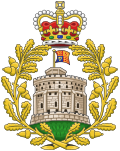 |
|
HM The Queen
|
Charles was born at Buckingham Palace on 14 November 1948, the first child of then Princess Elizabeth, Duchess of Edinburgh, and Philip, Duke of Edinburgh, and first grandchild of King George VI and Queen Elizabeth. Baptised in the palace's Music Room on 15 December 1948, using water from the River Jordan, by the Archbishop of Canterbury, Geoffrey Fisher, the Prince's godparents were: the King (his maternal grandfather); the King of Norway (his cousin, for whom the Earl of Athlone stood proxy); Queen Mary (his maternal great-grandmother); the Princess Margaret (his maternal aunt); Prince George of Greece (his paternal granduncle, for whom the Duke of Edinburgh stood proxy); the Dowager Marchioness of Milford Haven (his paternal great-grandmother); the Lady Brabourne (his cousin); and the Hon David Bowes-Lyon (his maternal great-uncle). By letters patent of Charles' great-grandfather, King George V, the titles of a British prince or princess, and the style Royal Highness, were only to be conferred on male-line children and grandchildren of the sovereign, as well as the children of the eldest son of the Prince of Wales. However, on 22 October 1948, George VI issued new letters patent granting these honours to any children of Princess Elizabeth and Prince Philip; otherwise, Charles would have merely taken his father's title, and been titled by courtesy as Earl of Merioneth. In this way, the children of the heiress presumptive had a royal and princely status.
When Charles was three, his mother's accession as Queen Elizabeth II, immediately made him the heir apparent to the then seven countries over which she now reigned. He was ipso facto elevated to the rank of Duke of Cornwall (by a charter of King Edward III that gave said title to the sovereign's eldest son), and, in the Scottish peerage, Duke of Rothesay, Earl of Carrick, Baron of Renfrew, Lord of the Isles, and Prince and Great Steward of Scotland. Though he moved to first in line to the throne in the United Kingdom order of precedence he is third, after his parents, and is typically fourth or fifth in other realms' precedence orders, following his mother, the relevant vice-regal representative(s), and his father. Charles attended his mother's coronation at Westminster Abbey in 1953, seated alongside his grandmother and aunt. As is customary for royal offspring, a governess, Catherine Peebles, was appointed and undertook his education between the ages of 5 and 8. Buckingham Palace announced in 1955 that Charles would attend school rather than have a private tutor, making him the first heir apparent ever to be educated in that manner.
Youth
Education
Charles first attended Hill House School in West London, receiving non-preferential treatment from the school's founder and then head, Stuart Townend, who advised the Queen to have Charles train in football, as the boys at Hill House were never deferential to anyone on the football field. The Prince then attended his father's former school, the Cheam Preparatory School in Berkshire, England; and was finally moved to Gordonstoun, in the north-east of Scotland. Reportedly the Prince despised his time at the latter school – "Colditz in kilts", as Charles put it – though he did spend two of his terms at the Timbertop campus of Geelong Grammar School in Geelong, Australia, during which time he visited Papua New Guinea on a history trip with his tutor, Michael Collins Persse. Upon his return to Gordonstoun, Charles emulated his father in becoming Head Boy, and left in 1967 with two A Levels in History and French.
Tradition was broken again when Charles proceeded straight from secondary school into university, as opposed to joining the Armed Forces. On the recommendation of Robin Woods, Dean of Windsor, and despite only gaining grades of B and C in his A Levels, the Prince was admitted to Trinity College, Cambridge, where he read anthropology, archaeology, and history, tutored by Canadian-born Professor John Coles. He graduated with a 2:2 Bachelor of Arts on 23 June 1970, the third Royal Family member to earn a university degree. On 2 August 1975, he was subsequently awarded a Master of Arts Degree from Cambridge, per the university's tradition. During his tertiary education, Charles also attended the Old College (part of the University of Wales, Aberystwyth), studying the Welsh language and Welsh history. He is the first Prince of Wales born outside of Wales ever to attempt to learn the language of the principality.
Created Prince of Wales
Charles was created Prince of Wales and Earl of Chester on 26 July 1958, though his investiture as such was not conducted until 1 July 1969, wherein he was crowned by his mother in a televised ceremony held at Caernarfon Castle, and gave his replies and speech in both Welsh and English. The following year he took his seat in the House of Lords, and later in the decade became the first member of the Royal Family since King George I to attend a British Cabinet meeting, having been invited by Prime Minister James Callaghan so that the Prince might see the workings of the British government and Cabinet at first hand. Charles also began to take on more public duties, founding his The Prince's Trust in 1976, and travelling to the United States in 1981.
Around the same time, the Prince expressed an interest in serving as Governor-General of Australia; Commander Michael Parker explained: "The idea behind the appointment was for him to put a foot on the ladder of monarchy, or being the future King and start learning the trade." However, because of a combination of nationalist feeling in Australia and the dismissal of the government by the Governor-General in 1975, nothing came of the proposal. Charles accepted the decision of the Australian ministers, if not without some regret; he reportedly stated: "What are you supposed to think when you are prepared to do something to help and you are told you are not wanted?" Conversely, Tom Gallagher wrote that Charles had been offered the Romanian throne by monarchists in that country; an offer that was reportedly turned down.
The Prince is at present the oldest man to hold the title of Prince of Wales since it became the title granted to the heir apparent. He is also the oldest heir apparent in Commonwealth realms' history, the second longest serving heir apparent, behind only Edward VII, and the third longest serving Prince of Wales in British history behind Edward VII and George IV, whom he will pass on 9 September 2017 if he is still Prince of Wales on that date. If he ascends to the throne after 18 September 2013, Charles would be the oldest monarch of the United Kingdom to do so; only William IV was older when he became monarch than Charles is now.
Military training and career
Following in the tradition of Princes of Wales before him, Charles spent time in the navy and air force. After Royal Air Force training that he requested and received during his second year at Cambridge, on 8 March 1971 the Prince flew himself to the Royal Air Force College Cranwell to train as a jet pilot. After the passing out parade in September of that year, he then embarked on a naval career, enrolling in a six week course at the Royal Naval College Dartmouth and then serving on the guided missile destroyer HMS Norfolk (1971–1972) and the frigates HMS Minerva (1972–1973) and HMS Jupiter (1974). Charles also qualified as a helicopter pilot at RNAS Yeovilton in 1974, just prior to joining 845 Naval Air Squadron, operating from HMS Hermes, and on 9 February 1976, the Prince took command of the coastal minehunter HMS Bronington for his last nine months in the navy. In total, Prince Charles has qualified to fly a Chipmunk basic pilot trainer, a Harrier T Mk.4 V/STOL fighter, a BAC Jet Provost jet pilot trainer, a Nimrod maritime patrol aircraft, a F-4 Phantom II fighter jet, an Avro Vulcan jet bomber, and a Spitfire classic WWII fighter.
Early romances
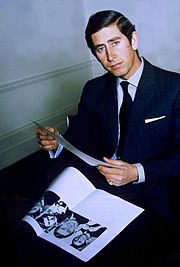
Prince Charles' love life was always the subject of speculation and press fodder. In his youth, he was linked to a number of women, including Georgiana Russell, daughter of the British Ambassador to Spain; Lady Jane Wellesley; Davina Sheffield; Fiona Watson, a model; Susan George; Lady Sarah Spencer; Princess Marie Astrid of Luxembourg; Dale, Baroness Tryon; Janet Jenkins; and Jane Ward. Not only is Charles the heir apparent to the thrones of the Commonwealth realms, a marriage was also expected to raise future monarchs. Consequently his choice of consort was going to create immense popular interest. In particular the reputation of the bride was going to be a major consideration, in addition to his mother's approval under the Royal Marriages Act 1772. Under this Act marriage to a Roman Catholic would automatically debar him and the marriage's Catholic issue from succession.
Charles was given written advice on dating and the selection of a future consort from his father's "Uncle Dickie", Louis Mountbatten, 1st Earl Mountbatten of Burma: "In a case like yours, the man should sow his wild oats and have as many affairs as he can before settling down, but for a wife he should choose a suitable, attractive, and sweet-charactered girl before she has met anyone else she might fall for... It is disturbing for women to have experiences if they have to remain on a pedestal after marriage." Mountbatten had a unique qualification for offering advice to this particular heir to the throne: he had invited George VI, Queen Elizabeth, and their daughters to visit Dartmouth Royal Naval College on 22 July 1939, having also detailed Cadet Prince Philip of Greece to keep the young princesses company, arranging the first documented meeting of Charles' future parents. In early 1974, Mountbatten began corresponding with Elizabeth and Philip's eldest son about a potential marriage to Mountbatten's granddaughter, Hon. Amanda Knatchbull (b. 26 June 1957), and recommended that the twenty-five year old prince get done with his bachelor's experimentation. Charles dutifully wrote to Amanda's mother, Lady Brabourne (who was also his godmother), about his interest in her daughter, to which she replied approvingly, though suggesting that a courtship was premature.
This did not daunt Mountbatten, who, four years later, obtained an invitation for himself and Amanda to accompany Charles on his 1980 tour of India. Both fathers, however, objected; Philip complaining that the Prince of Wales would be eclipsed by his famous uncle (who had served as the last British Viceroy and first Governor-General of India), while Lord Brabourne warned that a joint visit would rivet media attention on the cousins before they could decide on becoming a couple, thereby potentially dashing the very prospect for which Mountbatten hoped. However, before Charles was to depart alone for India, Mountbatten was killed in an IRA murder during August 1979. When Charles returned, he proposed to Amanda. However, in addition to her grandfather, she had lost her paternal grandmother and youngest brother Nicholas in the attack and now recoiled from the prospect of becoming a core member of the Royal Family. In June 1980, Charles officially turned down Chevening House, placed at his disposal since 1974, as his future residence. Chevening, a stately home in Kent, was bequeathed, along with an endowment, to the Crown by the last Earl Stanhope, Amanda's childless great-uncle, in the hope that Charles would eventually occupy it.
First marriage
Although Charles first met Lady Diana Frances Spencer in 1977—while visiting Diana's home, Althorp, as the companion of her elder sister, Sarah—he did not consider her romantically until the summer of 1980. While sitting together on a bale of hay at a friend's barbecue in July he mentioned Mountbatten's death, to which Diana replied that Charles had looked forlorn and in need of care during his uncle's funeral. Soon, according to Charles' chosen biographer, Jonathan Dimbleby, "without any apparent surge in feeling, he began to think seriously of her as a potential bride." She accompanied the Prince on visits to Balmoral and Sandringham, eliciting enthusiastic responses from most of the Royal Family.
Although the Queen offered Charles no direct counsel, his cousin Norton Knatchbull (Amanda's eldest brother) and his wife, Penny, did. But Charles was angered by their objections that he did not seem in love with Diana and that she seemed too awestruck by his position. Meanwhile, the couple continued dating, amidst constant press speculation and paparazzi coverage. When Prince Philip told him that the intrusive media attention would injure her reputation if he did not come to a decision about marrying her soon, and realising that Diana met the Mountbatten criteria (and, apparently, the public's) for a proper royal bride, Charles construed his father's advice as a warning to proceed without further delay.
Engagement and wedding to Diana
Prince Charles proposed to Diana in February 1981, she accepted, and when he asked her father for her hand, he consented. After the British and Canadian privy councils gave their approval for the union (which was sought as the couple was expected to produce an heir to those countries' thrones), the Queen-in-Council gave the legally required assent, and, 29 July, Charles and Diana were married at St Paul's Cathedral, before 3,500 invited guests and an estimated worldwide television audience of 750 million people. All of the Queen's Governors-General, as well as Europe's crowned heads, attended (save for King Juan Carlos I of Spain, who was advised not to attend because the newlyweds' honeymoon would involve a stop over in the disputed territory of Gibraltar). Most of Europe's elected heads of state were also amongst the guests, with the exceptions of the President of Greece, Constantine Karamanlis (who declined because Greece's exiled monarch, Constantine II, a kinsman and friend of the bridegroom, had been invited as "King of the Hellenes"), and the President of Ireland, Patrick Hillery (who was advised by Taoiseach Charles Haughey not to attend because of the dispute over the status of Northern Ireland).
The couple made their homes at Highgrove House, near Tetbury, and Kensington Palace. Almost immediately, the new Princess of Wales became a star attraction, chased by the paparazzi, and her every move followed by millions through the mass media. The couple had two children: Princes William (born 21 June 1982) and Henry (known as "Harry") (born 15 September 1984). Charles set precedent by being the first royal father to be present at his children's births.
Separation and divorce
The union between the Prince and Princess of Wales soon became troubled; within five years, the "fairytale" marriage was on the brink of collapse. The continued presence of Camilla Parker-Bowles in events and circumstances that also involved the royal couple became intolerable to Diana. Allies of Charles who spoke both publicly and off the record against Diana alleged that she was unstable and temperamental; one by one, she apparently secured the dismissal of many of Charles' long-standing staff members and fell out with his friends, as well as members of her own family– her father, mother, and brother– as well as members of the Royal Family, such as Sarah, Duchess of York. To the Palace's regret, the Princess sought counsel outside generally accepted sources of royal advice. In response to the succour sought by the Prince, Diana responded in kind. Charles, however, was also blamed for the marital troubles, as he resumed his adulterous affair with Parker-Bowles. Though they remained a couple in public, Charles and Diana had effectively separated by the late 1980s, the Prince living in Highgrove and the Princess at Kensington Palace. Their increased periods apart and obvious discomfort in each other's presence began to be noticed by the media, and this, plus evidence and recriminations of infidelity, were broadcast in tabloids and the news. By 1992 the marriage was over in all but name; in December of that year, then Prime Minister of the United Kingdom, John Major, announced in the British parliament the Prince and Princess' formal separation, after which the media began to take sides, starting what came to be known as the War of the Waleses. In October 1993, Diana wrote to a friend that she believed her husband was now in love with Tiggy Legge-Bourke and wanted to marry her. The marriage of Charles and Diana was formally ended in divorce on 28 August 1996.
On 31 August 1997, a year after the Prince and Princess divorced, Diana was killed in a car crash in Paris, along with her companion Dodi Fayed and driver Henri Paul. The Prince of Wales overruled the palace protocol experts– who argued that as Diana was no longer a member of the Royal Family, the responsibility for her funeral arrangements belonged to her blood relatives, the Spencers– and flew to Paris, with Diana's sisters, to accompany his ex-wife's body home. He also insisted that, as the mother of the presumed future king (her son William), she be given a formal royal funeral; a new category of formal funeral was especially created for her.
Second marriage
In 1993, the British tabloids came into the possession of recordings of a 1989 cell telephone conversation allegedly between the Prince of Wales and Camilla Parker-Bowles, in which Charles expressed regret for the indignities she had endured because of her relationship with him, and which revealed graphic expressions of a physical intimacy between the two.
Engagement and wedding to Camilla
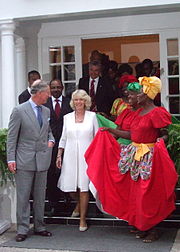
Clarence House announced on 10 February 2005 that Charles and Camilla Parker-Bowles were engaged; the Prince presented her with an engagement ring that had belonged to his grandmother. In a Privy Council meeting on 2 March, the Queen's consent to the marriage (as required by the Royal Marriages Act 1772) was recorded. In Canada, however, the Department of Justice announced its decision that the Queen's Privy Council for Canada was not required to meet to give its consent to the marriage, as the union would not result in offspring and thus would have no impact on the succession to the Canadian throne.
The marriage was to have been on 8 April of that year, and was to take place in a civil ceremony at Windsor Castle, with a subsequent religious blessing at St George's Chapel. But, because the conduct of a civil marriage at Windsor Castle would oblige the venue thereafter to be available to anyone wishing to be married there, the location was changed to the Windsor Guildhall. On 4 April it was announced that the marriage would be delayed by one day to allow for the Prince of Wales and some of the invited dignitaries to attend the funeral of Pope John Paul II. Charles' parents did not attend the marriage ceremony; the Queen's reluctance to attend arising from her position as Supreme Governor of the Church of England. The Queen and Duke of Edinburgh did, however, attend the service of blessing, and held a reception for the newlyweds at Windsor Castle, afterwards.
Act of Penitence
A unique feature during the Blessing of Charles and Camilla's marriage by the Archbishop of Canterbury was the inclusion of an act of penitence from the 1662 Book of Common Prayer. The royal couple led the congregation in declaring:
We acknowledge and bewail our manifold sins and wickedness, which we, from time to time, have committed by word, thought and deed, against thy Divine Majesty, provoking most justly thy wrath and indignation against us.
This, the "strongest act of penitence," was seen as propitiation for the royal couple's adulterous affair during their previous marriages.
Legality of Civil Wedding
The wedding made Charles the first member of the Royal Family to be civilly wed in England. Official documents had been published by BBC that stated such a marriage was illegal, though these were dismissed by Clarence House, and explained to be obsolete by the sitting government.
Personal interests
In his years as heir apparent, the Prince of Wales has taken on a wide array of interests and activities, and devoted his time and effort to charity work and collaborating with local communities. Since founding The Prince's Trust, he established fifteen more charitable organisations, and now serves as president of all of those, plus two others; together, these form a loose alliance called The Prince's Charities, which claim to raise over £110 million annually. Charles is also patron of over 350 other charities and organisations, and carries out duties related to these throughout the Commonwealth realms; for example, he uses his tours of Canada as a way to help draw attention to youth, the disabled, the environment, the arts, medicine, the elderly, heritage conservation, and education. The Prince was described by his ex-private secretary as a dissident who works against majority political opinions. Jonathan Dimbleby has reported that the Prince "has accumulated a number of certainties about the state of the world and does not relish contradiction."
The built environment
The Prince of Wales has frequently shared his views on architecture and urban planning in public forums, claiming to "care deeply about issues such as the environment, architecture, inner-city renewal, and the quality of life." He is known to be an advocate of neo-traditional ideas, such as those of Christopher Alexander and Leon Krier, which were illustrated in his 1984 attack on the British architectural community in a speech given to the Royal Institute of British Architects, describing a proposed extension to the National Gallery in London as a "monstrous carbuncle". Charles also published a book and created a documentary entitled A Vision of Britain, which critiqued some aspects of modern architecture. Despite criticism from the professional architectural press, the Prince has continued to put forward his views, stressing traditional urbanism, the need for human scale, and the restoration of historic buildings as an integrated element of new development and sustainable design. Two of the Charles' charities in particular forward his theories on design: The Prince's Regeneration Trust (formed by a merger of Regeneration Through Heritage and the Phoenix Trust in 2006) and The Prince's Foundation for the Built Environment (which absorbed The Prince of Wales's Institute of Architecture in 2001). Further, the village of Poundbury was created at the instigation of Prince Charles, with a master plan by Leon Krier.
Charles assisted with the establishment of a National Trust for the built environment in Canada, after lamenting, in 1996, the unbridled destruction of many of the country's historic urban cores. He offered his assistance to the Department of Canadian Heritage in the creation of a trust modelled on the British variant, and, with the passing of the 2007 federal budget by his mother's representative in Canada, a Canadian national trust was finally fully implemented. In 1999, the Prince also agreed to offer the use of his title to the Prince of Wales Prize for Municipal Heritage Leadership, awarded by the Heritage Canada Foundation to municipal governments that have shown sustained commitment to the conservation of historic places. Charles has also been the recipient of awards for his efforts in regard to architecture, such as the National Building Museum's Vincent Scully Prize he received in 2005, while visiting the United States and touring southern Mississippi and New Orleans to survey the damage caused by Hurricane Katrina; he donated $25,000 of the prize money to help restore communities damaged by the storm.
Starting in 1997, the Prince of Wales also visited Romania to view and draw attention to some of the destruction caused during the Communist rule of Nicolae Ceauşescu, particularly Orthodox monasteries and Saxon villages of Transylvania, where he purchased a house. Charles also became patron of two Romanian built environment organisations: the Mihai Eminescu Trust and the International Network for Traditional Building, Architecture, and Urbanism, an advocate of architecture that respects cultural tradition and identity. Charles also has “a deep understanding of Islamic art and architecture”, and has been involved in the construction of a building and garden at the Oxford Centre for Islamic Studies which combine Islamic and Oxford architectural styles.
Charles' involvement in architecture has also attracted controversy, especially his personal intervention to redesign projects whose architectural style or approach he has disagreed with. He has been especially opposed to styles such as modernism and functionalism. Richard Rogers, recipient of the Pritzker Prize and Stirling Prize, has described the Prince's personal intervention in projects as "an abuse of power" and "unconstitutional". In 2009 Charles wrote a letter to the Qatari royal family, the developers of the Chelsea Barracks site to be designed by Rogers, that suggested his design was "unsuitable". Subsequently, Rogers was removed from the project and The Prince's Foundation for the Built Environment was appointed to propose an alternative. Rogers has also claimed the Prince intervened to stop his designs for the Royal Opera House and Paternoster Square.
Charles' personal interventions have attracted critique from prominent members of the architectural community. Norman Foster, Zaha Hadid, Jacques Herzog, Jean Nouvel, Renzo Piano, and Frank Gehry among others wrote a letter to The Sunday Times to this effect; each is a recipient of the Pritzker Prize. They wrote that "private comments" and "behind-the-scenes lobbying" by the Prince counteracted the "open and democratic planning process" in the case of the Chelsea Barracks project. Similarly, Piers Gough CBE and other architects wrote a letter encouraging colleagues to boycott Charles' address to the Royal Institute of British Architects, with Gough calling Charles' views on architecture "elitist".
The natural environment
Since the early 1980s, Charles has taken a keen interest in environmental issues, taking a leadership role in promoting environmentally sensitive thinking. Upon his moving into his Highgrove estate, he became increasingly focused on organic farming, an attention that culminated in the 1990 launch of his own organic brand: Duchy Originals, which now sells more than 200 different sustainably produced products, from food to garden furniture, the profits from which (£6 million, as of 2008) are donated to The Prince's Charities. Documenting this work on his estate, Charles co-authored (with Charles Clover, environment editor of the Daily Telegraph) Highgrove: An Experiment in Organic Gardening and Farming, published in 1993, and offers his patronage to Garden Organic. Along similar lines, the Prince of Wales became involved with farming and various industries within it, regularly meeting with farmers to discuss their trade; though the 2001 foot-and-mouth epidemic in England prevented Charles from visiting farmers in Saskatchewan, organic farmers there came to meet him at the Assiniboia town hall. In 2004, he also founded the Mutton Renaissance Campaign, which aims to support British sheep farmers and make mutton more attractive to Britons. His organic farming efforts, however, attracted media criticism: According to The Independent in October, 2006 "...the story of Duchy Originals has involved compromises and ethical blips, wedded to a determined merchandising programme." and, in February 2007, Duchy products themselves came under attack, with the tabloid Daily Mail claiming that the food was "unhealthier than Big Macs." In 2007, Charles also launched The Prince's May Day Network, which encourages businesses to take action on climate change.
An announcement was made by Clarence House in December 2006 that the Prince of Wales would make his household's travel arrangements more eco-friendly, and, in 2007, Charles published in his annual accounts the details of his own carbon footprint, as well as targets for reducing his household's carbon emissions. That same year, he received the 10th annual Global Environmental Citizen Award from the Harvard Medical School's Centre for Health and the Global Environment, the director of which, Eric Chivian, stated: "For decades the Prince of Wales has been a champion of the natural world... He has been a world leader in efforts to improve energy efficiency and in reducing the discharge of toxic substances on land, and into the air and the oceans". However, Charles' travel by commercial airliner to the United States to attend the award ceremony drew criticism from some environmental activists, such as the Plane climate change action group's campaigner Joss Garman, and in April 2009, he faced similar criticisms for chartering a private jet for a five day tour of Europe to promote environmental issues.
The Prince gave a speech to the European Parliament on 14 February 2008, in which he called for European Union leadership in the war against climate change. During the standing ovation that followed, Nigel Farage, the leader of the United Kingdom Independence Party (UKIP), was the only MEP to remain seated and went on to describe Charles's advisers as "naive and foolish at best." Farage continued: "How can somebody like Prince Charles be allowed to come to the European Parliament at this time to announce he thinks it should have more powers? It would have been better for the country he wants to rule one day if he had stayed home and tried to persuade Gordon Brown to give the people the promised referendum [on the Treaty of Lisbon]."
The Prince gave a speech to the Low Carbon Prosperity Summit in a European Parliament chamber on 9 February 2011, in which he lashed out at climate change skeptics. He said they are playing "a reckless game of roulette" with the planet's future and are having a "corrosive effect" on public opinion. He also spoke about the need to protect fisheries, the Amazon rain forest and about making low-carbon emissions affordable and competitive.
Philosophies and religious beliefs
Sir Laurens van der Post became a friend of Charles in 1977, a relationship which led him to be dubbed the "guru to Prince Charles", and made godfather to Charles' son, Prince William. From him, the Prince of Wales developed a focus on philosophy, especially that of Asian and Middle Eastern nations, and New Age theology, praising Kabbalistic artworks, and penning a memorial for Kathleen Raine, the Neoplatonist poet, who died in 2003.
The Prince is known to attend services at several different Anglican churches near his home at Highgrove, Gloucestershire and is known to regularly worship at Crathie Kirk when staying at Balmoral Castle. In 2000, he was appointed as Lord High Commissioner to the General Assembly of the Church of Scotland.
The Prince of Wales also travels (amidst some secrecy) each year to Mount Athos to spend time in the Orthodox monasteries there, as well as in Romania, demonstrating his interest in Orthodox Christianity. Along with his father, who was born and raised as Greek Orthodox, Charles is patron of The Friends of Mount Athos, as well as the 21st International Congress of Byzantine Studies. It is also believed that Prince Charles has an Orthodox icon corner in his house where he keeps the majority of his Orthodox icons. None of this is surprising, as Prince Charles' father was raised Greek Orthodox, but converted in order to marry his present wife, Queen Elizabeth II. It is reported that in more recent years, even his father, Prince Philip has joined him in occasional retreats to the peninsula.
Charles is also patron of the Oxford Centre for Islamic Studies at the University of Oxford.
Alternative medicine
Charles has demonstrated an interest in alternative medicine, and his promotion of it has occasionally resulted in controversy. In 2004, Charles' Foundation for Integrated Health divided the scientific and medical community over its campaign encouraging general practitioners to offer herbal and other alternative treatments to National Health Service patients, and in May 2006, Charles made a speech to an audience of health ministers from various countries at the World Health Assembly in Geneva, urging them to develop a plan for integrating conventional and alternative medicine and argued for homeopathy.
In April 2008, The Times published a letter from Edzard Ernst that asked the Prince's Foundation to recall two guides promoting "alternative medicine", saying: "the majority of alternative therapies appear to be clinically ineffective, and many are downright dangerous." A speaker for the foundation countered the criticism by stating: "We entirely reject the accusation that our online publication Complementary Healthcare: A Guide contains any misleading or inaccurate claims about the benefits of complementary therapies. On the contrary, it treats people as adults and takes a responsible approach by encouraging people to look at reliable sources of information... so that they can make informed decisions. The foundation does not promote complementary therapies." Ernst has recently published a book with science writer Simon Singh condemning alternative medicine called Trick or Treatment: Alternative Medicine on Trial. The book is ironically dedicated to "HRH the Prince of Wales" and the last chapter is very critical of his advocacy of "complementary" and "alternative" treatments.
The Prince's Duchy Originals produce a variety of CAM products including a “Detox Tincture” that Professor Edzard Ernst has denounced as "financially exploiting the vulnerable" and "outright quackery". In May 2009, the Advertising Standards Authority criticised an email that Duchy Originals had sent out to advertise its Echina-Relief, Hyperi-Lift and Detox Tinctures products saying it was misleading. The Prince personally wrote at least seven letters to the Medicines and Healthcare products Regulatory Agency (MHRA) shortly before they relaxed the rules governing labelling of such herbal products, a move that has been widely condemned by scientists and medical bodies.
On 31 October 2009 it was reported that Prince Charles had personally lobbied Health Secretary Andy Burnham regarding greater provision of alternative treatments in the NHS.
In 2010, following accounting irregularities noted by the auditor, two former officials at the Prince's Foundation were arrested for fraud believed to total £300,000. Four days after the arrests, the FIH announced that it would close, claiming that it "has achieved its key objective of promoting the use of integrated health." The charity's finance director, accountant George Gray, was convicted of theft totalling £253,000 and sentenced to three years in prison. The Prince's Foundation was re-branded and re-launched in late 2010 as the College of Medicine. It continues to act as an alternative medicine lobby group.
Humanitarian issues
The plight of various peoples has been a target of Charles' efforts, predominantly the long-term unemployed, people who have been in trouble with the law, people who are in difficulty at school, and people who have been in care. The Prince's Trust is the main outlet through which Charles works with young people, offering loans to groups, business people, and others who have had difficulty receiving outside support. Fundraising concerts are regularly held in benefit of the trust, with leading pop, rock, and classical musicians taking part. In Canada, Charles has also supported humanitarian projects, taking part, along with his two sons, in the ceremonies marking the 1998 International Day for the Elimination of Racial Discrimination, and helping to launch the Canadian Youth Business Foundation in Saskatchewan in 2001, when he also visited Scott Collegiate, an inner-city school in Regina.
After spending time in the Northwest Territories in 1975, Charles formed a special interest in the Canadian north, as well as Canada's Aboriginal Peoples, the leaders of which he met and sometimes took time to walk and meditate with. Reflecting this association, the Prince of Wales has been conferred with special titles from First Nations communities: in 1996, Cree and Ojibway students in Winnipeg named the Prince Leading Star, and in 2001 he was dubbed Pisimwa Kamiwohkitahpamikohk, or "the sun looks at him in a good way", during his first visit to the province of Saskatchewan. He was also one of the first world leaders to express strong concerns about the human rights record of Nicolae Ceauşescu, initiating objections in the international arena, and subsequently supported the FARA Foundation, which runs Romanian orphanages.
Charles attended the Bilderberg Group conference in 1986 specifically to attend a debate on the South African economic crisis.
Hobbies and sports
Since his youth, the Prince was an avid player of polo, as a part of competitive teams until 1992, and strictly for charity from then until 2005, after which he ceased to participate because of two notable injuries he suffered during play: in 1990 he broke his arm, and in 2001 was briefly unconscious after a fall. Charles also frequently took part in fox hunting, before the sport was banned in the United Kingdom in 2005. By the late 1990s, as opposition to the activity was growing, the Prince of Wales' participation in this activity was viewed as a "political statement" by those opposed to it, such as the League Against Cruel Sports, which launched the attack against Charles after he took his sons on the Beaufort Hunt in 1999, at a time when the government was trying to ban the hunting of foxes with hounds. The Prince has also been a keen salmon angler since youth, and a supporter of Orri Vigfússon's efforts to protect the North Atlantic Salmon. Charles has frequently fished the River Dee in Aberdeenshire, Scotland, while he claims his most special angling memories are from his time in Vopnafjörður, Iceland.
Charles has also pursued the visual arts, focusing on watercolour, and exhibiting and selling a number of his paintings, as well as publishing books on the subject. In university he dabbled in acting, appearing in amateur productions of a comedic nature, an enjoyment of which continued later into the Prince's life, as evidenced by his organising of a comedy gala to celebrate his 60th birthday. He also has an interest in illusionism, becoming a member of The Magic Circle after passing his audition by performing the cups and balls effect. The Prince acts today as patron of a number of theatres, acting troupes, and orchestral ensembles, including the Regina Symphony Orchestra, and the Royal Shakespeare Company, and is reportedly a fan of Canadian singer and song writer Leonard Cohen. He is also a collector of automobiles, particularly the British marque Aston Martin, having acquired numerous models and such tight connections with the brand–being a frequent visitor to the factory and its service department, and a guest of honour at most of the company's special launch events– that special Prince of Wales edition Aston Martins have been created on occasion.
Charles is a supporter of Burnley Football Club.
Official duties
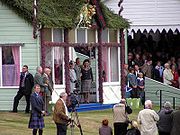
As Prince of Wales, Prince Charles undertakes a number of official duties on behalf of his mother, in her role as sovereign of any of the Commonwealth realms. He will frequently stand in for the Queen at the funerals of foreign dignitaries (which the Queen customarily does not attend), and at investitures into British orders. It was when he attended the funeral of Pope John Paul II that Charles caused controversy: when shaking hands with other guests, Charles was surprised to find himself shaking that of Robert Mugabe, the President of Zimbabwe, who had been seated next to the Prince. Charles' office subsequently released a statement saying: "The Prince of Wales was caught by surprise and not in a position to avoid shaking Mr. Mugabe's hand. The Prince finds the current Zimbabwean regime abhorrent. He has supported the Zimbabwe Defence and Aid Fund which works with those being oppressed by the regime. The Prince also recently met Pius Ncube, the Archbishop of Bulawayo, an outspoken critic of the government."
Both Charles and the Duchess of Cornwall travel abroad on behalf of the United Kingdom. The Prince has been regarded as an effective advocate of the country, with his visit to the Republic of Ireland, where he delivered a personally researched and written speech on Anglo-Irish affairs that was warmly received by Irish politicians and the media, being cited as an example. His service to the Canadian Armed Forces permits him to be informed of troop activities, and allows him to visit these troops while in Canada or overseas, taking part in ceremonial occasions. For instance, in 2001, the Prince placed a specially commissioned wreath, made from vegetation taken from French battlefields, at the Canadian Tomb of the Unknown Soldier, and in 1981 he became the patron of the Canadian Warplane Heritage Museum.
Prince Charles makes regular tours of Wales, going there for a week of engagements each summer, attending important national occasions, such as opening the Senedd. In 2000, Charles revived the tradition of the Prince of Wales having an official harpist, in order to foster Welsh talent at playing the harp, the national instrument of Wales. He and the Duchess of Cornwall also spend one week each year in Scotland, where the Prince is patron of a number of Scottish organisations.
Prince Charles is a Director of "The Royal Collection Trust", with no listed occupation.
Residences
Clarence House, the former London residence of the late Queen Elizabeth, the Queen Mother, is the Prince of Wales' current official residence. Previously, he resided in an apartment at St James's Palace. Charles also holds a private estate in Gloucestershire, Highgrove House, and one in Scotland, the Birkhall estate near Balmoral Castle and also previously owned by the Queen Mother. Upon the occasion of his marriage to Diana, Charles had reduced his voluntary tax contribution from the profits generated by the Duchy of Cornwall from 50% to 25%.
In 2007, the Prince purchased a 192 acre (150 acres of grazing and parkland, and 40 acres (160,000 m2) of woodland) property in Carmarthenshire, and applied for permission to convert the farm into a Welsh home for him and the Duchess of Cornwall, to be rented out as holiday flats when the royal couple is not in residence. Though neighbours said the proposed alterations flouted local planning regulations, the application was put on hold while a report was drafted on how the alterations would affect the local bat population. Charles and Camilla took residence at the new property, called Llwynywermod, in June 2008.
In 2006 and 2008 respectively, the Prince purchased two properties in south-eastern Transylvania. In 2006 he bought a house in the village of Viscri which is one of the Saxon villages with fortified churches in Transylvania designated in 1993 as a World Heritage Site by UNESCO. In 2008 he bought another house in the village of Valea Zălanului / Zalánpatak, situated in the Székely Land region of Transylvania, a 16th century village which was probably founded by one of the Prince's Transylvanian ancestors. Both properties are rented out as guest houses when the Prince is not in residence.
Titles, styles, honours and arms
Titles and styles
Charles has held a number of titles throughout his life, as the grandson of the monarch, the son of the monarch and, later, honoured in his own right with princely and noble titles. When in conversation with the Prince of Wales, the practice is to initially address him as Your Royal Highness and thereafter as Sir.
There has been speculation as to what regnal name the Prince will choose upon his succession to the throne. If he keeps his current first name, he will be known as Charles III. However, it has been reported that Charles has suggested he may choose to reign as George VII in honour of his maternal grandfather, and to avoid association with the Stuart kings Charles I (who was beheaded) and Charles II (who had lived in exile), although he has denied this publicly.
Honours and honorary military appointments
On his 58th birthday, the Prince of Wales was appointed by his mother as a General in the British Army, an Admiral in the Royal Navy, and an Air Chief Marshal of the Royal Air Force. (He had previously been granted at an earlier point the rank of Major General and the accompanying ranks in the other services.) His first honorary appointment was as Colonel-in-Chief of the Royal Regiment of Wales in 1969; since that time, the Prince has also been installed as Colonel-in-Chief, Colonel, Honorary Air Commodore, Air Commodore-in-Chief, Deputy Colonel-in-Chief, Royal Honorary Colonel, Royal Colonel, and Honorary Commodore of at least 36 military formations throughout the Commonwealth. He is also the commander of the Royal Gurkha Rifles, which is the only foreign regiment in the British army.
Charles has also been the recipient of a number of honours and awards from various countries. He has been inducted into eight orders and received five decorations from amongst the Commonwealth realms, and has been the recipient of 17 different appointments and decorations by foreign states, as well as nine honorary degrees from universities in the United Kingdom and New Zealand.
Arms
|
||||||||||||||||||||||||||||||||||
Ancestry
| Ancestors of Charles, Prince of Wales | ||||||||||||||||||||||||||||||||||||||||||||||||||||||||||||||||||||||||||||||||||||||||||||||||||||||||||||||||||||||||||||||||||||||||||||||||||||||||||||||||||||||||||||||||||||||||||||||||||||||||||||||||||||||||||||||||||||||||||||||||||||||||||||||||||||||||||||||||||||||||||||||||||||||||||||||||||||||||||||||||||||||||||||||||||||||||||||||||||||||||||||||||||||||||||||||||||||||||||||||||||||||||||||||||||||||||||||||||||||||||||||||||||||||||||||||||||||||||||||||||||||||||||||||||||||||||||||||||||||||||||||||||||||||||||||||||||
|---|---|---|---|---|---|---|---|---|---|---|---|---|---|---|---|---|---|---|---|---|---|---|---|---|---|---|---|---|---|---|---|---|---|---|---|---|---|---|---|---|---|---|---|---|---|---|---|---|---|---|---|---|---|---|---|---|---|---|---|---|---|---|---|---|---|---|---|---|---|---|---|---|---|---|---|---|---|---|---|---|---|---|---|---|---|---|---|---|---|---|---|---|---|---|---|---|---|---|---|---|---|---|---|---|---|---|---|---|---|---|---|---|---|---|---|---|---|---|---|---|---|---|---|---|---|---|---|---|---|---|---|---|---|---|---|---|---|---|---|---|---|---|---|---|---|---|---|---|---|---|---|---|---|---|---|---|---|---|---|---|---|---|---|---|---|---|---|---|---|---|---|---|---|---|---|---|---|---|---|---|---|---|---|---|---|---|---|---|---|---|---|---|---|---|---|---|---|---|---|---|---|---|---|---|---|---|---|---|---|---|---|---|---|---|---|---|---|---|---|---|---|---|---|---|---|---|---|---|---|---|---|---|---|---|---|---|---|---|---|---|---|---|---|---|---|---|---|---|---|---|---|---|---|---|---|---|---|---|---|---|---|---|---|---|---|---|---|---|---|---|---|---|---|---|---|---|---|---|---|---|---|---|---|---|---|---|---|---|---|---|---|---|---|---|---|---|---|---|---|---|---|---|---|---|---|---|---|---|---|---|---|---|---|---|---|---|---|---|---|---|---|---|---|---|---|---|---|---|---|---|---|---|---|---|---|---|---|---|---|---|---|---|---|---|---|---|---|---|---|---|---|---|---|---|---|---|---|---|---|---|---|---|---|---|---|---|---|---|---|---|---|---|---|---|---|---|---|---|---|---|---|---|---|---|---|---|---|---|---|---|---|---|---|---|---|---|---|---|---|---|---|---|---|---|---|---|---|---|---|---|---|---|---|---|---|---|---|---|---|---|---|---|---|---|---|---|---|---|---|---|---|---|---|---|---|---|---|---|---|---|---|---|---|---|---|---|---|---|---|---|---|---|---|---|---|---|---|---|---|---|---|---|---|---|---|---|---|---|---|---|---|---|---|---|---|---|---|---|---|---|---|---|---|---|---|---|---|---|---|---|---|---|---|---|---|---|---|---|---|---|---|---|---|---|---|---|---|---|---|---|---|---|---|---|---|---|---|---|---|---|---|---|---|---|---|---|---|---|---|---|---|---|---|---|---|---|---|---|---|---|---|---|---|---|---|---|
|
||||||||||||||||||||||||||||||||||||||||||||||||||||||||||||||||||||||||||||||||||||||||||||||||||||||||||||||||||||||||||||||||||||||||||||||||||||||||||||||||||||||||||||||||||||||||||||||||||||||||||||||||||||||||||||||||||||||||||||||||||||||||||||||||||||||||||||||||||||||||||||||||||||||||||||||||||||||||||||||||||||||||||||||||||||||||||||||||||||||||||||||||||||||||||||||||||||||||||||||||||||||||||||||||||||||||||||||||||||||||||||||||||||||||||||||||||||||||||||||||||||||||||||||||||||||||||||||||||||||||||||||||||||||||||||||||||
Through his father's line, his patrilineal descent, Charles is a member of the House of Schleswig-Holstein-Sonderburg-Glücksburg, a branch of the House of Oldenburg. In the United Kingdom, in the absence of any future decrees to the contrary, Charles will use the name Windsor as a monarch.
Issue
| Name | Birth | Marriage | Issue | |
|---|---|---|---|---|
| Prince William of Wales | 21 June 1982 | |||
| Prince Henry of Wales | 15 September 1984 | |||
